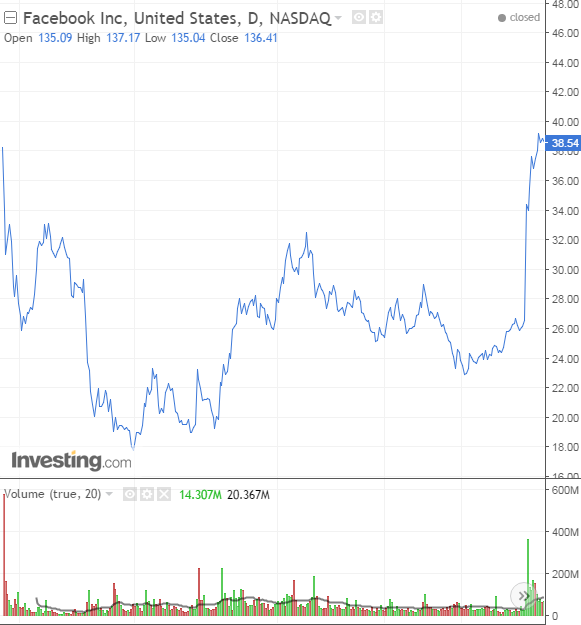Snap Inc., the Los Angeles, California based holding company that employs 1860 people and primarily produces the popular Snapchat image messaging application, is set to begin trading on the NYSE—ticker symbol SNAP—on Thursday, March 2, most probably before noon eastern time. The exact hour hasn't yet been disclosed and is at the discretion of the underwriters. However, if Facebook's (NASDAQ:FB) or Twitter's (NYSE:TWTR) initial public offerings (IPOs) are indicative, sometime between 10:30am to 11:30am seems most likely.
Snap's main product is the Snapchat application which allows users to send pictures and videos that will self-delete after a few seconds. The app also allows users to add filters, text or even emoji to their pictures and videos before sending. SNAP will begin trading at an anticipated price range between $15 and $16 dollars per share. The IPO is expected to raise $3 to 3.2 billion USD for the company, which would then have a market cap of about $20 to $22 billion dollars.
This is perceptibly lower than the $25 billion initial valuation for the company, probably the result of lessons learned from the aftermath of Facebook's relatively messy and embarrassing IPO in May of 2012. Facebook's price was revised upward just before trading opened, but shares trended down at the starting gate. Snapchat understandably prefers a lower valuation, increasing the chances of an upward trend as it debuts in public markets.
From a fundamental perspective, Snap is problematic. By law, the company was required to submit just two years of audited financial reports to the SEC, even though Snap was founded in 2011. During the two years chosen, 2015 and 2016, the company had operating losses of $381 and $520 million dollars respectively. Its revenue went from $58 million in 2015 to $404 million dollars during that same time. As of 2016, 96% of Snap's revenue came from advertising. During December 2016, Snapchat had 158 million active daily users. For that same period, Facebook had 1.17 billion daily actives.
IPO investing is always risky. There's often a dearth of information available about the privately held company before it goes public, forcing investors to make assumptions that may or may not be correct in order to perform due diligence on the offering; the knowledge gap between sellers (insiders) and buyers (the public) can be vast, and the hype surrounding the IPO, as well as the media attention that brings, often leaves an impression that the company's situation and prospects may be better than they actually are.
With that in mind, here are four major risks to keep an eye on when Snap begins trading on Thursday:
1. Where's the Growth?
Snap's hefty valuation relies on expectations of its future earning power. As discussed above, the company is young and still losing hundreds of millions of dollars. When will they turn profitable? That's anyone's guess.
In order to thrive, Snap has to continue to innovate as well as pull in more users to its platforms. Which means high R&D expenses for the foreseeable future. However, the company also needs to be smart about its routes to monetization. Facebook, for example, was always profitable. Twitter still isn't.
While Snapchat is more similar to Facebook because of its visually oriented platform and method of revenue generation (ads in a 'feed'), Snap's ability to continue to grow revenue remains a very real concern, especially since Facebook and Google (NASDAQ:GOOGL) are the behemoths in the room that already have a lock on online advertising revenue because of their ability to target and deliver millions of targeted consumers.
2. Ongoing Facebook Threat
And speaking of Facebook, the company and its various platforms (Facebook, Messenger, WhatsApp, and particularly Instagram) are and will remain Snapchat's biggest threats going forward. Since Facebook has 25 times Snapchat's revenue in Free Cash Flow alone, it's a serious threat. Add Facebook's 1.17 billion daily active users, and the differences in size and reach between the two companies is blatant, and could be deleterious for Snap.
While size differences alone shouldn't necessarily be a major cause for concern, Facebook's ongoing efforts at replicating the Snapchat experience should be worrying Snap. After adding filters to the camera in its app, and launching 'Instagram stories', Facebook's WhatsApp now allows users to upload visual statuses to share with contacts.
The fact that Facebook isn't being sued for infringement, since they're literally copying Snapchat's primary features, speaks volumes about the smaller company's inability to defend the innovation that makes it unique. Snap also owns Snapchat Spectacles, a hardware product that's a camera inside glasses. One presumes that will be more difficult to duplicate, though right now it's also not a significant revenue generator for the company. Without additional, ongoing innovation—and perhaps even then—if Facebook can easily recreate the experience, any innovation won't be worth much to Snap.
3. Management and Corporate Governance
Snap's founders are Evan Spiegel (26) and Bobby Murphy (28). They created the platform while they were students at Stanford and have been running the company ever since. Here again, Facebook comparisons seem appropriate, since Mark Zuckerberg was also once a young entrepreneur building a company while at an Ivy League university. However the investment risk here doesn’t stem from the two founders' youth (although Spiegel was involved in a frat boy type controversy), but from the nature of the shares Snap is issuing. The Class A shares that will be available to the public have absolutely no voting power whatsoever. The S-1 filing clearly states:
Mr. Spiegel and Mr. Murphy, and potentially either one of them alone, have the ability to control the outcome of all matters submitted to our stockholders for approval.
Which means that buying these publicly traded shares means an investor would have a share in all the risk without having even the slightest say in how the company is managed.
4. Markets Take Their Time
If there is one thing we've learned from recent IPOs—namely Facebook, Twitter and Alibaba (NYSE:BABA)—for the first year after the IPO the market hasn't got a clue how to appropriately price these companies. During its first year of trading, Twitter opened at $40, went as high as $74, then dropped back to $29 before heading lower still. As of yesterday's close it's trading at $16.
When it IPO'd, Facebook opened at $42, plunged to $18 and only then, about a year after it first went public, it began its ascent to today's $136. Alibaba opened at $92, peaked at $120 and dropped to $57 within a year, before trending back up. It now trades for $103. While this may be encouraging for traders looking to make a relatively quick buck by going long or shorting IPOs at the top, longer term investors should stay away from Snap right now, but keep an eye on the company's, and the equity's, progress if so inclined.

